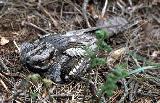|
 
- This has to be one of the more exciting birds of our area as well as being one of the species to benefit from the forest management. Nightjars are summer visitors, arriving in May to breed. They occupy forest clearings, where they nest on the ground, making only a shallow depression for their eggs. As soon as they return from their wintering grounds to the south, the males will establish territory. As dusk falls, they start their territorial churring, a fascinating noise that is very un-birdlike. This is usually issued from a 'singing post', often a tall tree on the edge of their territory, and the sound made more eerie as the bird twists its head slowly from side to side.
All activity takes place during the evening and night, the birds remaining motionless on the ground during the hours of daylight, relying on their cryptic colouration to render them undetectable. They feed on moths and other flying insects, catching them in their large gaping mouths. As a male defends its territory, it will fly around a series of singing posts, interrupting its churring with a strange whistle and some wing clapping.
Because of their behaviour, most people are probably completely unaware of the presence of Nightjars. They return each year, to go through the whole breeding cycle, and then fly back to warmer climes over the winter period. Dog-walkers probably pass within a few metres of day-roosting birds, without noticing them.
The preferred habitat of Nightjars has been open heathland, a much-threatened habitat. As the habitat disappeared, this species declined markedly in numbers. Then, as felling started in coniferous forests such as Thetford, new and suitable clearings appeared. When such areas are re-planted, Nightjars will continue to breed amongst the growing trees provided the gaps between remain clear enough for take-off. Nightjars move in to newly cleared areas very quickly, setting up territory during the first breeding season that such areas appear.
The Thetford Forest population of Nightjars continues to increase and is very healthy.
|
|
|
|
|
|
|
|
|
|
|
|
|
|
|
|
|
|
|
Copyright 2016 TJKSoftware,Icehouse Media, ~ designed & maintained by
TJKSoftware
